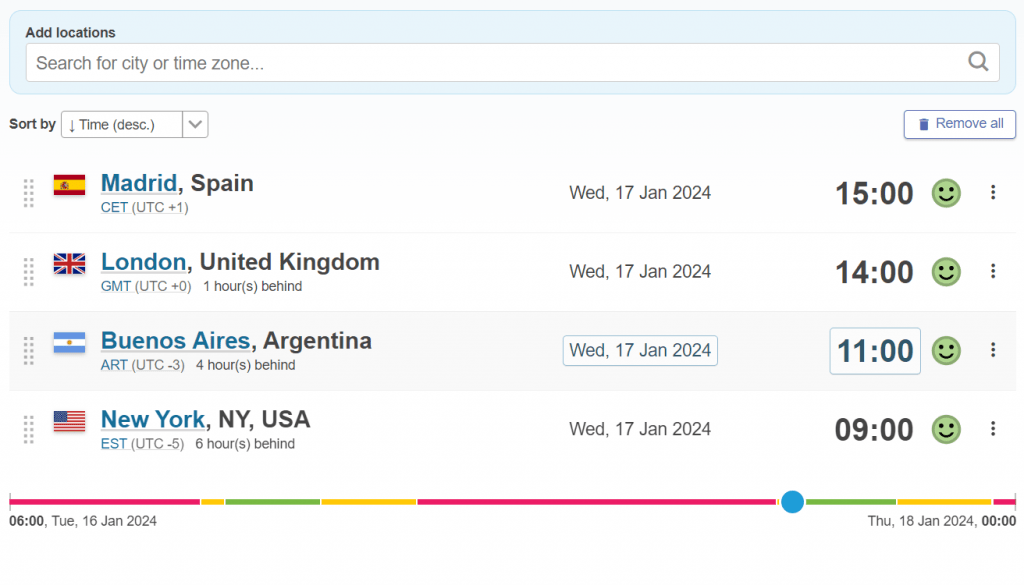If you’re working as part of a globally remote business, collaborating with colleagues in different countries and time zones needs to feel like second nature. But how do you ensure that you can work effectively across different time zones and get the best results?
Maximise crossover Time
While it may not always be the case, there’s a chance you’ll have periods of time when your business hours will overlap. Use these times to collaborate effectively, and to get the information you need. This means that even when one of you isn’t available, you should still be able to stay in sync and work effectively across different time zones.
I recommend utilising tools such as timeanddate.com. They offer a useful time zone conversion feature, which allows you to quickly see what hours will work best for collaboration.
 It also goes without saying that if you feel a video meeting is necessary, you should always try to make sure it takes place at a time which is mutually convenient and during these crossover periods.
It also goes without saying that if you feel a video meeting is necessary, you should always try to make sure it takes place at a time which is mutually convenient and during these crossover periods.
Be clear on expectations
It’s always important to set clear expectations to be mindful of others. If you’re working on a project or task with someone in a different time zone, there are going to be times when you can’t reach them, or need to wait for a response.
Make sure to communicate your availability to colleagues, and to take the time to check in with others. This doesn’t mean you need to be working the exact same hours each day, but team members should have a clear idea about when they should expect a response.
Set Boundaries
It’s also important to set your own boundaries. While it can be tempting to check your email before going to bed, or to log into slack at an odd hour, this can become an unhealthy habit. It can result in colleagues expecting instant replies or updates, when this isn’t realistic.
Be sure to make these boundaries visible. For example, take the time to update your Slack status if you’re not available, or consider blocking your calendar during the times you won’t be available. This will make it easier for colleagues to understand your working hours, as well as respect your boundaries.
Use a company time zone
It can be helpful at an organisational level to use a company time zone. This might be based on where your head office sits, or where the majority of team members are based. It can be advantageous especially when communicating company meeting times or deadlines and help reduce confusion. If one is in place, take the time to make sure it’s being respected – otherwise there’s no point having one to begin with.
Embrace asynchronous communication
Working async has numerous benefits, and becomes essential when collaborating across time zones. Instead of expecting colleagues to reply instantly, async communication is based around the concept of allowing team members the freedom to work on projects and reply to messages at a time that works for them (for example, within 24 hours). It relies on respecting timeframes, and good communication practices.
Overall, it has a number of benefits – both for team members and the organisation. At an employee level, it gives individuals the opportunity to leverage greater flexibility. Instead of having to operate according to rigorously fixed hours, people can instead take advantage of true flexibility – completing work according to their personal schedule and responsibilities. This allows the opportunity for concentrated work, without the pressure of needing to instantly reply to an email, or a notification on slack – thus allowing for greater productivity.
You’ll only be able to maximise the advantages, however, if everyone respects this way of working. It means practicing strong communication habits, as well as utilising the right tools. Consider encouraging the use of platforms such as Loom, as well as promoting good internal documentation, for example through a company knowledgebase. Everyone should know where they’re expected to go for the information they need, as well as how they should be sharing their work and updates.
Promote a global mindset
To truly get the most from being a global business, and to maximise the benefits of working with colleagues across different time zones, it’s essential to foster a global mindset. Take the time to understand and explore different cultures, as well as embrace this at an organisational level.
Consider the times of key company meetings and social events. Simple steps such as rotating the times – so that those located in different time zones still have the opportunity to join – can make a huge difference. Likewise, take the time to celebrate cultural events and holidays.
Utilise the correct tools
In this article, we’ve explored some of the tools you can use to work effectively across time zones – but of course, there are many, many more. There are numerous products and platforms you can use to promote collaboration in a globally remote context. Take the time to explore the different choices available, and utilise the ones which will best support your mission.
Also be mindful to ensure these tools you use are correctly utilised – as far as possible, the whole organisation should be using the same platforms, and sharing key information in one place. This way, you’ll be well placed to collaborate effectively, and benefit from the results.
What are your top tips for working effectively across time zones? What are some of the key challenges you’ve experienced? I’d love to hear your thoughts!









